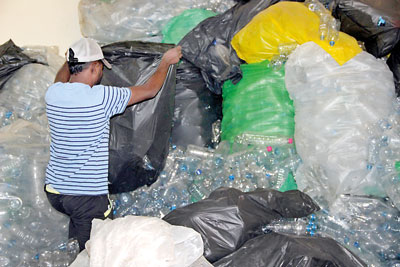
Nuwara Eliya Municipal Council employs new garbage system
At a time when effective ways of managing garbage are being explored increasingly, the Nuwara Eliya Municipal Council (NEMC) has managed to put in place a comprehensive garbage management system. Only last month, a plastic and polythene recycling centre at the municipality’s sanitary landfill site at Sandathenna(Moon Plains) also commenced operations.
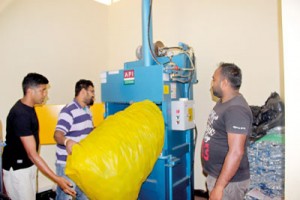
Plastic bottles being compressed at the centre
Spread over two hectares, the Moon Plains sanitary landfill was established in 2004 at a cost of Rs.17 million as a project funded by the Japan International Cooperation Agency (JICA). In July 2015, authorities also established a plastic and polythene recycling centre at the site.
The centre however, did not have electricity. It finally commenced operating on July 12, this year.
JICA conducted an assessment on the project which revealed that in a land area covering some 12.43 square kilometres in Nuwara Eliya, 25 out of 32 tonnes of garbage from 5,791 households, 3,520 businesses and 803 Government units are brought to the Moon Plains sanitary landfill. About 12 tonnes go towards making carbonic fertiliser.
Towards the end of 2015, the Nuwara Eliya Municipality also replaced its garbage carts with trucks and lorries.
In addition, the NEMC pasted 350 notices throughout the town informing residents about garbage management and the times that their garbage will be collected.
Within a span of about one and a half years, Nuwara Eliya residents have learned to hand over their garbage to tractors and lorries put in place to replace garbage carts.
D.B. Mavussawa, Chief Public Health Inspector (PHI) of the NEMC told the Sunday Times that 90 percent of people in Nuwara Eliya town were now segregating their garbage.
About two percent still don’t do so and this was a major problem, he maintained. “They continue to hand over unsegregated garbage to our lorries and we have to sort the garbage at the landfill site. As we have now started recycling plastic and polythene, we need to ensure that the item is clean when putting it in the recycling machine. This becomes a difficult exercise if garbage is unsegregated.”
He said the municipality’s garbage lorries and trucks have stopped accepting unsegregated garbage and have started collecting general waste, plastic and polythene separately.
Nuwara Eliya Municipal Commissioner Ruwan Ratnayake said while the Municipality’s garbage management program has earned widespread recognition, it was still far from perfect. Some Government institutions are still expressing reluctance to segregate their garbage, he alleged. “However, we are firm in our stance not to accept unsegregated garbage. When the entire country is adopting one approach, it is our duty to fall in line,” he pointed out.

Plastic bottles being collected at the centre

The plastic and polythene recycling centre
Source – 06/08/2017, The Sunday Times, See more at – http://www.sundaytimes.lk/170806/news/nuwara-eliya-municipal-council-employs-new-garbage-system-253317.html
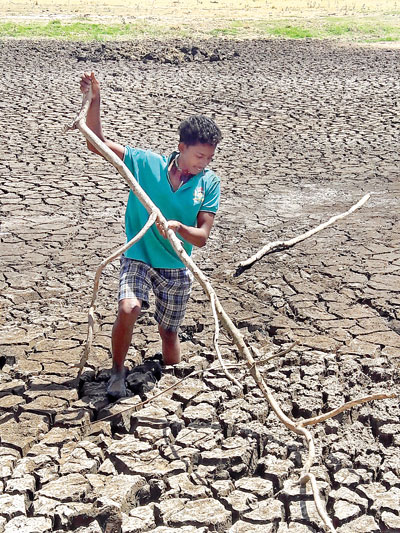
Govt scours, scrambles for potable water for the drought-affected
With the remaining water sources continuing to dry up, the task of finding safe drinking water for over a million people affected by the prolonged drought, is becoming more challenging by the day.
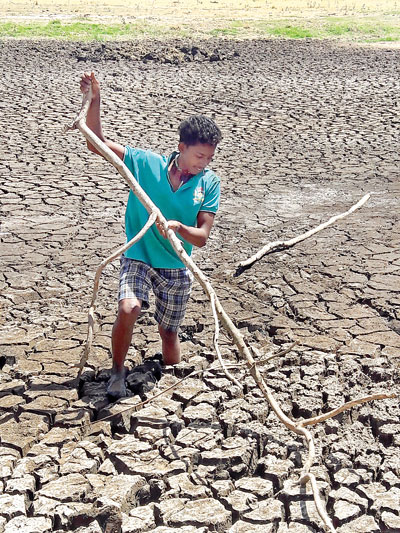
Thousands face severe economic hardships due to the devastation of their agricultural crops and livelihoods by the drought.Pic by Karuwala Gaswewa Jayaratne
In the worst affected areas such as Kurunegala, Puttalam and Trincomalee, authorities are scrambling to transport and distribute drinking water to tens of thousands, who are also facing severe economic hardships due to the devastation of their agricultural crops and livelihoods by the drought.
According to the Disaster Management Center’s (DMC) drought situation report issued at 9 am yesterday (5), over 1.1 million persons from more than 341,000 families in 137 Divisional Secretariat Divisions, are affected by the drought. Fifteen Districts are severely affected, while two others are moderately affected, said DMC Assistant Director Pradeep Kodippili.
Kurunegala District is the worst affected, with 151, 262 persons affected by the drought, while the Trincomalee District had 140,938 affected persons. Putta lam, Jaffna and Mullaitivu had over 100,000 persons affected by the drought.
Mr Kodippili noted that providing drinking water to the affected was the biggest challenge faced by authorities, with Rs 40 million already allocated for this purpose. Over 200 new bowsers and 6,000 water storage tanks had been sent to affected areas within the past few months.
District DMC offices were coordinating with District and Divisional Secretariats, Pradeshiya Sabhas and Grama Niladhari Divisions in distributing drinking water and conducting other drought relief efforts in affected areas.
The Govt is initiating drought relief measures in two ways, Minister of Disaster Management, Anura Priyadarshana Yapa told the Sunday Times. One aspect is the distribution of safe drinking water to affected areas, while the other is providing relief to families whose crops have been destroyed or damaged by the drought.
Bowsers and tractor-mounted bowsers have been dispatched to affected areas to distribute drinking water, the Minister pointed out. “We are also distributing water storage tanks, but have found the numbers are not sufficient,” he acknowledged. Accordingly, measures have been taken to purchase more water tanks for the drought-hit areas.
Additionally, the Sri Lanka Navy is also involved in setting up sea water purification plants in places such as Jaffna.
Meanwhile, efforts are also under way to provide relief to those affected by the drop in agricultural produce. Accordingly, the Govt will be distributing relief packs with Rs 5,000 worth of essential food items to each family in the affected districts every month for the duration of the drought.
According to Minister Yapa, initial estimates put the amount of funds required for the distribution of relief packs alone at Rs 2.5 billion per month. “It’s a huge economic burden,” he observed, “But, there’s nothing much we can do about that. People need relief.”
“The parcels will be distributed through Co-operatives and Sathosa outlets after District Secretariats send details of the affected in their respective Districts,” he further said.
The Sunday Times also spoke to officials in several Districts severely affected by the drought, regarding the situation in their areas. In the Puttalam District, 15 of its 16 Divisional Secretariat Divisions are affected by drought and the main difficulty now faced by authorities is finding water sources in the district to fill bowsers to supply affected areas, said Assistant District Secretary W.M.C.K. Wanninayake. “Most water sources have dried up and the ones that remain are not enough. We are currently faced with the prospect of not being able to find enough drinking water to distribute,” he stressed.
“Therefore, in addition to distributing water via bowsers, officials had requested funds to construct temporary wells near tanks,” he added. “Funds have also been requested to clean disused tube wells.”
“Compensation for damage caused to crops was also being paid at Rs 10,000 per affected family in the first round. The Rs 5,000 relief packs would also be distributed in the coming days,” said Mr Wanninayake.
“If the drought continues, there are fears the region’s coconut production too would be severely damaged,” he added.
The Trincomalee District faces a similar problem, as all water sources in the Gomarankadawala Divisional Secretariat Division have run dry. “The only way we can get drinking water to Gomarankadawala now is by transporting it all the way from Trincomalee in bowsers,” revealed DMC’s Trincomalee Assistant Director K. Sugunathas.
Mr Sugunathas said that, “However, all necessary equipment and funds have been made available for officials to provide relief, with a large bowser capable of transporting 13,000 litres of water was delivered this week.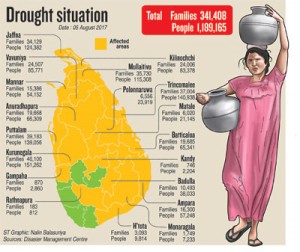
In Kurunegala, 30 bowsers have been dispatched to distribute drinking water,” said Additional District Secretary R.M.R. Rathnayake. The drought has had a severe impact on paddy cultivation, with only about 25% to 30% of paddy lands cultivated during this season.
Matale District Secretary D.P.G. Kumarasiri meanwhile, has instructed his Grama Niladharis to furnish daily reports to their respective Divisional Secretariats regarding details of families sans access to drinking water or, forced to purchase drinking water from shops or, travelling long distances to obtain water. Such data enables authorities to identify areas urgently in need of water, so they can provide it free of charge,” he explained.
According to Mr Kumarasiri, Galewela, Dambulla and Wilgamuwa areas in the district were the worst affected, with 70 Grama Niladhari Divisions directly impacted by drought.
Minister Anura Priyadarshana Yapa stated the Govt expected such drought relief measures to be in place for a short term as the Dept of Meteorology has forecast the current drought to prevail till the end of September or beginning of October. “The coming monsoon is forecast to be a normal one, with many rice producing areas severely hit by the present drought, getting sufficient water,” the Minister remarked. He however, added there was always the chance this would not happen, in which case the current relief measures will have to continue.
The Minister outlined the need for implementing short, mid and long term measures to mitigate effects of drought. “The reason is that, we have seen our monsoons are now periodically failing. The main culprit is climate change, the effects of which are being increasingly felt,” he opined.
“While the Govt would take whatever steps possible, the public also had a duty to conserve water. Whether you have your own water resource or, if you purchase water from the Govt, you need to understand that water is now a scarce commodity. Wastage must stop,” the Minister insisted.
Source – 06/08/2017, The Sunday Times, See more at – http://www.sundaytimes.lk/170806/news/govt-scours-scrambles-for-potable-water-for-the-drought-affected-253345.html

Famed tusker dies of wounds
A famed tusker in the Udawalawe known as ‘Hambegamuwe Ethaa’ has died after prolonged illness despite the best efforts of veterinarian to save its life.
The tusker was found while in severe distress on Thursday on the bund of the Rathambala Wewa in the park’s border with Hambegamuwa. The park’s eterinarians immediately began treatment on the elephant, but it passed away last evening (4).
Veterinary physicians who treated the tusker said the animal had five bullet wounds in its body as well as several deep cuts. The cuts had become severely infected and were life threatening, they added.
The tusker was about 40 years of age at the time of death.
According to the census on the country;s elephant population conducted in 2011, there were only about 120 tuskers left in the wild.
Story and Pics by Rahul Samantha Hettiarachchi in Hambantota
Source – 08.08/2017, Times Online, See more at – http://www.sundaytimes.lk/article/1028959/famed-tusker-dies-of-wounds
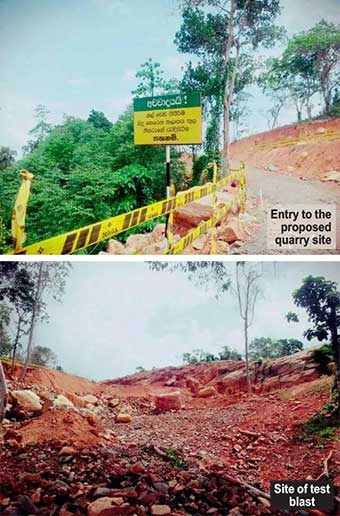
Destruction of Ritiagla
-tas-1.jpg)
One of the fountains in Rilagala
Ritiagla yaya (mountain range) located in Beliatta divisional secretary area in Hambantota district demarcates the boundary between Matara and Hambantota districts. Possessing predominantly a wet zone climate and fauna, this mountain range is unique for a number of reasons. One is that it remains an important water store for the region. Another is that it is located shoulder to shoulder with the Maha-yaya forest reserve, into which it extends. Also it is the home to a number of fauna and flora, some in fact face extinction.
The first attempt at quarrying Rilagala began in March 2016 when test blasting of the rock was undertaken by a road building company. The reason was to supply the boulders and metal for the construction of the Matara – Beliatta stretch of the Sothern Expressway extension. However, this found immediate stiff opposition from the villagers. The momentum of public protests reached a peak in July 2016, when the Centre for Environmental and Nature Studies (CENS) and Rilagala Yaya Surekeeme Ekamuthwa (Coalition for protection of Rilagala Yaya) along with the villagers held a press briefing at the Centre for Society and Religion (CSR) Colombo to explain the Colombo based media what was going on 200 km South of the capital city.
“Through that we brought the Rilagala issue to the forefront of the country’s environment agenda”, quipped Ven. Wekadawela Rahula Thero of the CENS.
-tas-2.jpg) Various activities ranging from pocket meetings, legal clinics to street dramas were held to make the villagers aware of the consequences of the destruction of Rilagala. The issue received a new twist when it was taken up by the Southern Provincial Council on 25 April 2017, where a resolution was unanimously passed acknowledging the importance of this mountain range to the environment and to the lives of the people in Hambantota district and thus, prohibiting its destruction. In this regard it drew extensively from the report compiled by the CENS on the ecological significance of Rilagala yaya. However, following a lull of many months the destruction has reportedly started again in Rilagala.
Various activities ranging from pocket meetings, legal clinics to street dramas were held to make the villagers aware of the consequences of the destruction of Rilagala. The issue received a new twist when it was taken up by the Southern Provincial Council on 25 April 2017, where a resolution was unanimously passed acknowledging the importance of this mountain range to the environment and to the lives of the people in Hambantota district and thus, prohibiting its destruction. In this regard it drew extensively from the report compiled by the CENS on the ecological significance of Rilagala yaya. However, following a lull of many months the destruction has reportedly started again in Rilagala.
“Now they have cleared the forest and have brought all the machinery needed to commence the quarrying activities”, said Ven. Rahula Thero.
Commenting on the availability of alternatives for the supply of metal for the expressway construction Thero said, “There are number of quarries in Hambantota district from which they could obtain metal if they want. But the company wants it from Rilagala to reduce the transport cost and to maximize its profits”.
Governmental Agencies – Partners in crime
He further said, “They have also obtained the necessary permission from the governmental agencies like Geological Survey and Mining Bureau (GSMB), National Building Research Organization (NBRO), Wildlife Conservation Department, Forest Department, Water Resources Board, Archeology Department, Survey Department, Urban Development Authority, Agrarian Development Department and Divisional Secretariat Beliatta to go ahead with their sleazy business. But because of the public resentment they had to take a step back. They have refrained from blasting the rock thus far”.
Commenting on the overall conduct of some governmental agencies Ven. Thero said, “It is a tragedy that the governmental agencies that are there to safeguard the environment and the social life of people now do just the opposite teaming up with the companies”.
Maha-yaya forest was declared a forest reserve during the British colonial rule, in 1940. It extends over 339 hectares at present. The massif Rilagala that immediately adjoins it is within its catchment area. It stands 784 feet tall, and is the third highest zenith of Hambantota district. Rilagala sits together with three other massifs namely, Kongaslanda, Murungagala and Kotigala in the same mountain range.
Ecological value
-tas-3.jpg) Rilagala is especially important for its water retaining potential. Its water stores help in maintaining the water table and feeding the streams and waterways flowing from the mountain range. It also feed eight fountains, namely godellagoda ulpatha, madola ulpatha, magawatte ulpatha, eldeniya ulpatha, wewa kumbura ulpatha, ittagalara ulpatha, puhulgathara and thennahena. It provides water for the drinking and irrigational needs of the adjacent villages, namely Punchi aranya, Maha aranya, Thamba gal-lella and up to Yatiyana.
Rilagala is especially important for its water retaining potential. Its water stores help in maintaining the water table and feeding the streams and waterways flowing from the mountain range. It also feed eight fountains, namely godellagoda ulpatha, madola ulpatha, magawatte ulpatha, eldeniya ulpatha, wewa kumbura ulpatha, ittagalara ulpatha, puhulgathara and thennahena. It provides water for the drinking and irrigational needs of the adjacent villages, namely Punchi aranya, Maha aranya, Thamba gal-lella and up to Yatiyana.
Among the fish species found in the streams in Rilagala include Puntius nigrofasciatus (Black Ruby barb/ Bulath hapaya), Puntius titteya (Cherry barb/ Le titteya), Belontota signata (Ceylonese combtail/ Thalkossa), Rasbora vaterifloris (Pearly rasbora/ Halmal dandiya), Rasbora wilpita (Wilpita dandiya), Channa orientalis (Smooth breasted snake head/ Kolakanaya), Puntius bimaculatus (Two spotted barb/ Ippilakadaya ) and Puntius dorsalis (Long-snouted barb/ Katupethiya). Among these, all except the last two are endemic to Sri Lanka, while all are threatened of extinction.
Risk of landslides
In December 2014, the NBRO issued a landslide warning to the area after identifying deforestation activities as a major risk factor for the landslides in the area. In October 2015 there had been an earth slip that led to evacuation of three families from their original homes.
“Then how come the authorities can issue a license for quarrying Rilagala?” questions Ven. Thero with raised eyebrows.
The director, CENS Dr. Ravindra Kariyawasam spoke to “The Island” from Italy.
“We have organized a mass campaign against this destruction. That is the real strength of the struggle to save Rilagala”, quipped Dr. Kariyawasam.
“We have already filed a human rights case against the Rilagala issue. We have already informed various authorities including the President about this issue. And we expect to file a case in the Supreme Court in the near future as well”, summed up Dr. Kariyawasam.
No approval as yet
Assistant Director, Central Environment Authority (CEA) at Hambantota district office when contacted denied that the massif in question is part of the Rilagala yaya. “No, that’s just a rock without a name” he said.
On the cleared up forest cover he said, “That was done to do the test blast”.
He further said, “By now the Initial Environmental Examination (IEE) has been done and the necessary approval of the relevant authorities has been obtained. But the approval for quarrying has not been granted”.
According to the Assistant Director, the IEE had been conducted by a company that comes under the GSMB. When the GSMB is one of the authorizing agencies, one can also question the ethicality of a company that comes under it providing technical services to a project that depends on its independent opinion for its implementation.
He agreed that the resolution passed at the Southern Provincial Council was taken due cognizance of for not granting authorization for the project by the CEA.
Source – 03/08/2017, The Island, See more at – http://www.island.lk/index.php?page_cat=article-details&page=article-details&code_title=169348

SC extends restraining order on dumping garbage at Muturajawela
-Ckg--FINAL-1.jpg)
By Chitra Weerarathne
The Supreme Court yesterday extended till September 21, the restraining order, preventing the Colombo Municipal Council from dumping garbage in the Muturajawela sanctuary.
A group of residents in that area had complained that the dumping of garbage pollutes the environment and contaminates the water wells used by many people.
Among the respondents are the Colombo Municipal Council and the Municipal Commissioner of Colombo.
The bench comprised Justice Buwaneka Aluwihare, Justice Sisira de Abrew and Justice Anil Gooneratne.
Source – 03/08/2017, The Island, See more at – http://www.island.lk/index.php?page_cat=article-details&page=article-details&code_title=169363

Suspect arrested with wallapatta

A suspect who attempted to smuggle out a stock of wallapatta from the Katunayake International Airport has been arrested.
Deputy Customs Director Parakrama Basnayake said that the haul of wallapatta was recovered from the baggage of a person who arrived at the Airport to leave for Chennai.
The stock of wallapatta weighed eight kilogrammes and its value is reported to be around 600,000 rupees.
The 27-year-old suspect is reported to be a Colombo resident.
Source – 01/08/2017, ITN, See more at – http://www.itnnews.lk/local-news/suspect-arrested-with-wallapatta/

268 apprehended for improper disposal of garbage

268 persons have been arrested for the disposal of garbage haphazardly in the Western Province. They were taken into custody during raids carried out on the 28th and 29th of last month.
The highest number taken into custody was from the Mount Lavinia division. It was around 60. 48 have been taken into custody from the Colombo North area. The number arrested from Colombo Central was 27.
A total of 41 have been apprehended from the Colombo South area for improper disposal of garbage. Also 39 persons have been rounded up from the Nugegoda Division, while 37 persons have been taken into custody from the Gamapha Division.
The Police Headquarters reported that individuals who had been engaged in the illegal disposal of garbage from the Kelaniya and Negombo Division have also been taken into custody. Cases will be filed against these persons by the respective Police Stations. The Police emphasized that they will continue to carry out such raids.
Source – 01/08/2017, ITN, See more at – http://www.itnnews.lk/local-news/268-apprehended-for-improper-disposal-of-garbage/

Consciousness can impact action,’ leading the way for a new normal in swimwear and resortwear fashion


- Multidisciplinary expert discussion at TrendSwim presented by Swim Week Colombo
The second session of TrendSwim focused on ‘Good and Sustainable Fashion – Earth Conscious Future’. With the exponential growth in the global swimwear market, trends are changing at a faster pace than ever. TrendSwim’s first session focused on the key aspects surrounding this rapidly-evolving industry. The second session focuses on good and sustainable fashion, building an earth conscious future, sustainability practices and industry perspective.
Speakers were Ajai Vir Singh, President/Founder of Colombo Fashion Week, Designer for Conscience; Sarinda Unamboowe, CEO/Managing Director at MAS Kreeda; David Abraham, Creative Director, Abraham and Thakore, design resources for fashion, accessories and home textile products; Shiranee E. Yasaratne, Advisor to Bio Diversity Sri Lanka; and Anoma Wijewardene, Artist.
Following are excerpts:
Q: Ajai, this is the third edition of swim week and the second TrendSwim discussions. But you have a stronger, deeper commitment to this year’s Swim Week. You’ve discussed about wanting to create a new normal in design and manufacturing of the fashion industry here. What is the difference and what’s your vision for swim week going forward?
Ajai: The statistics associated with the apparel industry are staggering. Beginning 15 years ago with the Garments without Guilt campaign. Policing does not work, while the research is available, a conscious change of heart is required in order to create this new normal. All designers showcasing this year have a green impact story which will be created into an awareness campaign. If you can change the heart, make it greener, the impacts will be viable. We intend to create a platform which is an ecosystem for fashion and apparel in Sri Lanka – designers, manufacturers, suppliers who all share the same vision. If we start now, in five years or so, the results will be visible.
Q: Recently I was reading that we need to move from just being sustainable to being regenerative. It seems as if MAS is trying to do just that. Can you tell us a little bit about the macro large scale efforts that MAS is spearheading and how it has also become possible to do this?
Sarinda: Our industry is one of the biggest polluters in the industry and if action is not taken now to mitigate these impacts, the repercussions will be catastrophic. Even as designers, try and utilise as much of the fabric as possible. What we don’t consider is the amount of waste which adds to landfills. Be conscious of your waste produced.
Recently, MAS has tied up with the Biyagama zone to implement a material recovery centre. A collection point for separation – fabric, perishable waste, etc. will be separated and incinerated as necessary and recycle what can be. Innovations have allowed to produce yarn from recycled fabrics. We have also begun mining existing landfills to reduce and plant a green cover over it
The SL Navy shredders are collecting marine pollution which is crushed and brought to a company which produces yarn, currently used in paint brushes but will be made into fabric in the very near future in the island itself.
Sustainable fabric is no longer an unaffordable commodity. Commercially viable fabrics now exist which can be created 100% recyclable fabrics. MAS occupies a large acreage of land in Sri Lanka, all the roofs are being converted to solar roofs within the next two years. For every acre, 1:10 and then 1:100 reforestation by 2025.
Q: Can you give us an overall view of how Sri Lanka as a whole is responding to the environment, climate, social sustainability agenda?
Shiranee: Over the years, people’s perception of environmentalists have changed. The private sector is now volunteering. Biodiversity financing study looking at the amount of financing that the State is putting into conservation. There is no enabling environment for biodiversity conservation in Sri Lanka despite being a world biodiversity hotspot.
Although we work with high end companies who already established environmental responsibility.
70% of industry are SMEs which don’t understand the impact of environmental responsibility. Therefore, it is necessary to handhold these companies to guide them in the right direction.
Q: We have been talking largely about ecological and environmental aspects. But our footprint, our impact is much more complex. It’s social and cultural too. You want to preserve and nurture your cultural heritage. Your design and fashion philosophy is built around classicalism rather than being trendy. You want to create fashion that lasts than are short lived. How does this speak to the sustainability agenda?
David: The quicker, shorter and more wasteful the consumption cycle is, we are not going to be sustainable. We try to incorporate longevity and quality to make a product last longer. Lower quality is associated with faster, cheaper fashion. We work with small craftspeople and look at the cultural aspect of sustainability. I think it is imperative that we sustain these livelihoods and make better the living situation of the craftspeople by ensuring sustain of their craft. Sustainability has a very wide definition.
Q: How do you see the claims made by some, that big fashion brands are guilty of cultural misappropriation?
David: Capitalises ideas from everywhere and anywhere without much conscience. It is interesting that people are more aware of this. One of the key ingredients of fashion is the cannibalism of ideas. We live in a time where ideas spread within seconds. Ideas are shifting. Enforcement may not be possible but important that these issues are raised, addressed and acknowledged by the large brands. Creation does not have a geographic or political boundary. We are well within a digital space which inspires everything around us.
Q: So I am going to ask the simple question… in times like these, how can art save us? Or how is art saving you?
Anoma: I’ve used poetry, art, books I’ve read in the past, what people have been talking about for years, celebrating nature. Accept that we are fundamentally a part of nature and we are not able to see this and associate ourselves with it, and so we continue to degrade and destroy the environment because of human greed, remind ourselves that we are nature and we destroy ourselves if we carry on this path. It is my passion to get this to people and to move and inspire people to change their hearts. Diversity in collaboration to celebrate and love nature.
Source – 02/08/2017, DailyFT, See more at – http://www.ft.lk/article/632741/%E2%80%98Consciousness-can-impact-action—leading-the-way-for-a-new-normal-in-swimwear-and-resortwear-fashion

Myanmar gifts a Tusker
A tusker has been gifted by former President of Myanmar Thein Sein to President Maithripala Sirisena, Diyawadana Nilame Pradeep Nilanga Dela told Ceylon Today.
The tusker has already been shipped out from Myanmar and will be arriving in Sri Lanka soon.
The Nilame also said that the tusker will take part in next year’s Kandy Esala Perahera, as there is not enough time for it to participate in this year’s Kandy Esala Perahera. (RJ)
Source – 03/08/2017, Ceylon Today, See more at – http://www.ceylontoday.lk/article20170401CT20170930.php?id=5908

Public urged to boycott polythene and help traditional bag weavers
Cottage industries of Sri Lanka will need time to catch up with demand for shopping bags made of natural materials when the ban on polythene bags and polystyrene containers becomes effective in September despite protests by manufacturers.
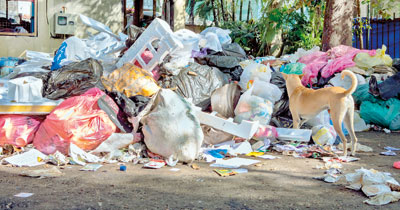
City garbage mostly consists of polythene. Pic by Sameera Weerasekera
Households are also being encouraged to boycott polythene bags for the sake of freeing Sri Lanka from the non-biodegradable garbage mountains nightmare.
There are those who already use reusable cotton tote bags for their shopping, but they are few. Colourful handloom bags are also available.
People are also being urged to use re-usable lunch boxes and banana leaves when they can.
The Central Environment Authority insists that the ban will be imposed this time on polythene lunch sheets, grocery bags, shopping bags and polystyrene food containers. It has failed on several previous occasions.
Waste Management (Plastics), Director, Ajith Weerasundera said there will be no phase out period. “The ban has been approved by the cabinet and will be implemented on 1st September,’’ he said.
Statistics reveal 27% of the garbage collected from households contain polythene and polystyrene products.
On two occasions, the CEA tried to ban polythene – once in 2007 when Maithripala Sirisena was Minister of Environment. The law was never implemented. Again in December 2015, after Mr Sirisena became President, he tried to revive the law and failed.
Meanwhile, leading supermarkets, shops and retail outlets have been generously handing out polythene shopping bags. Vendors at wet markets are also liberally providing polythene bags – even for a single papaya, or a bunch of plantains. But alternatives are available.
The head of the Field Ornithology Group of Sri Lanka, Professor Sarath Kotagama said: “Discourage the consumer from using the product and the businesses will stop production. There are always alternatives – we should take our own traditional ‘malla’ for shopping.’’
He said waste paper should be used to make grocery bags.
“If third world countries including Bangladesh and Nigeria have done it we can do it. We need polythene only for items that have a shelf life,’’ he said. Also it is important that biodegradable, reusable and photo-degradable material are used to wrap food. “This way we can push out non-biodegradable polythene/polystyrene from our markets.’’
He added: “Consumer resistance is crucial. They can give the message to manufacturers by boycotting polythene and polystyrene products. When consumer consumption patterns change the manufacturers will change, too.’’
But traditional reed, jute and palmyrah industries are not yet ready to provide alternative products for shopping and packaging. Many of the cottage industries need support, specially from the state. The lack of demand and high costs have also affected the traditional reed products industry.
A study done by the Ruhuna University in the Kalutara District revealed that most people owned enough land for reed cultivation and 65% of the women had the technical knowledge to make reed products including shopping bags and baskets. The study also recommended diversification to revitalise the industry that could bring quality products into the market.
The palmyrah industry which could step in is largely confined to the northern region. A study by the Hector Kobbekaduwa Agrarian Research and Training Institute on palmyrah products found that it could fill only around 2% of the void created by the polythene and polystyrene ban.
Additional Director, R L M Jayatissa said the industry was underprepared. “It is a cottage based industry it would take time to take over,’’ he said.
However CEA’s, Weerasundera sounded positive and said these industries are being looked at with a plan to revive them. He suggested that people use lunch boxes and banana leaves instead of lunch sheets and also use traditional bags for shopping.
Source – 30/07/2017, The Sunda Times, see more at – http://www.sundaytimes.lk/170730/news/public-urged-to-boycott-polythene-and-help-traditional-bag-weavers-252506.html






